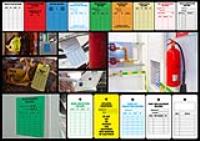 Add My Company
Add My Company
Sign In

When you work with tools, you want to keep them organised. There’s nothing worse than misplacing something. It leads to missed deadlines, inefficient working and a lot of frustration.
For those who clock into a workshop every day, tool management is an essential part of the job. It’s non-negotiable to sort out your equipment, and we’re here to show you how.
Below, we discuss how to organise tools in a workshop, how to mark tools and the importance of categorising them with equipment markers.
Where To Store Tools
There are many ways to organise your tools:
Shelving: quick, easy and simple to set up. Shelves aren’t suitable for all equipment as they usually involve storing at height, but they suit most tools. We’ve covered shelving in a previous blog post: Shelve It: How to Label Warehouse Racking
Drawers: Everyone’s familiar with drawers. These are ideal when storing tools that aren’t used all the time.
Storage bins/cabinets: These are ideal for tools that aren’t used on a day-to-day basis, much like drawers. We recommend marking these warehouse document holders, which can convey detailed information quickly.
Magnetic strips: These can store items like kitchen knives and metallic tools. They are ideal for tools used regularly and pair well with magnetic labels. We’ve discussed magnetic labels in a separate blog: How to Decide Between Magnetic and Non-Magnetic Labels
So, now that you know where to store tools, how do you do so efficiently?
How to Organise Tools
Here are three key tips to keep any on how to organise tools by category:
Group Similar Items Together
Sure, it’s obvious, but organising tools by function is the best way to do things. Alternatively, you can group items by size.
Grouping by function brings a major benefit: it allows you to have access to all the tools you need for each stage of your job. For example, a job may consist of different types of repairs. By grouping tools together, you can have all you need for each stage, minimising the time it takes to find key tools.
Experiment With Colour Coordination
Colour coordination is a staple for a key reason: it’s universal. Most people can recognise colour, and it’s much quicker for the human brain to process than words or numbers.
You can colour code using a few things: equipment labels, floor markers or shelf labels. Ensure staff are educated on what each colour means – for example, you could store all large tools under yellow, then all small tools under red.
The food industry uses colour coding heavily and is the cornerstone of good, sanitary kitchen safety.
Make The Most Of Vertical Space
Whenever you need to maximise space, think vertical. Too often, workplaces and workshops don’t make the most of vertical space.
It’s essential to preserve as much floor space as possible in a workshop, especially if it’s a garage. Leaving enough room for your staff to work safely is a priority. Use shelves, pins, cork boards, cupboards and whatever else to keep floor space clear.
You need to prioritise safety. Stacking up tools and dangerous, heavy equipment is a surefire way to lead to danger.
Marking Tools: Why It’s Important and How To Do It
A messy workshop causes a few issues. It sends signals that you don’t know what you’re doing to customers. You can judge a professional for the state of his workshop.
A disorganised workshop usually means you’ll have less time spent working and more time spent looking for things. Disorganisation ruins efficiency, leading to a lower volume of work, missed deadlines, more stress and safety issues.
Sometimes, to rectify a potentially dangerous problem, you need to find a tool quickly. In a disorganised workshop, this is difficult and can mean the difference between a small issue solved quickly and a big problem that spins out of control.
Usually, disorganisation leads to safety problems, too: when tools and equipment aren’t stored, then slips, trips and falls usually follow.
For example, 33% of accidents are from slips, trips and falls, which make up the bulk of workplace incidents. If these places were organised, the likelihood of an accident occurring would reduce.
How Our Equipment Markers Help
Keeping organised isn’t about buying the right labels; it requires the correct protocols and mindset for it to succeed.
However, having the correct labels is a good start. Get organised and browse our range of equipment markers today.
For all other safety news, follow our Twitter to catch the latest.
For more information on Keeping Tabs: How to Use Equipment Markers To Organise Workplace Tools talk to Label Source
Enquire Now
List your company on FindTheNeedle.

